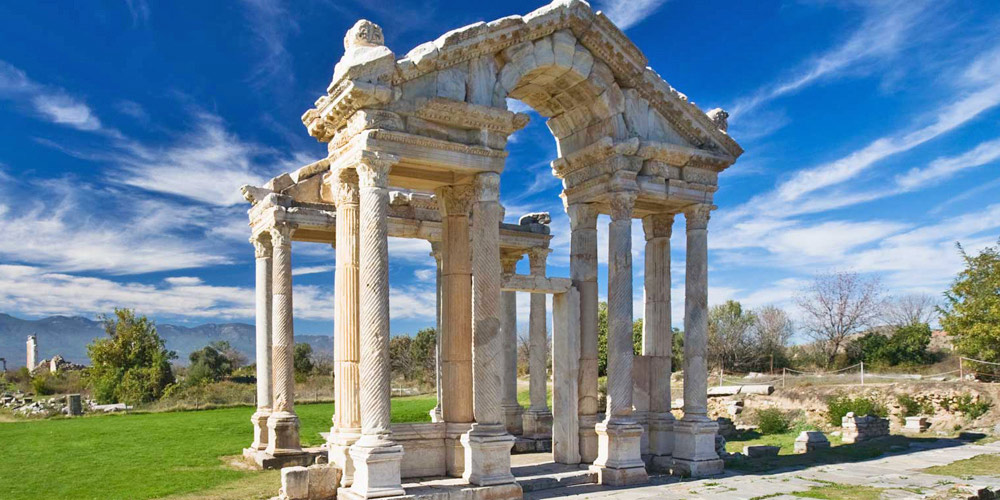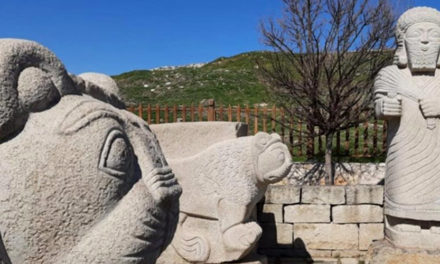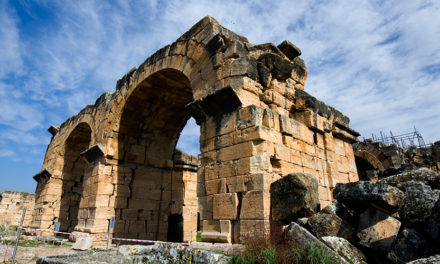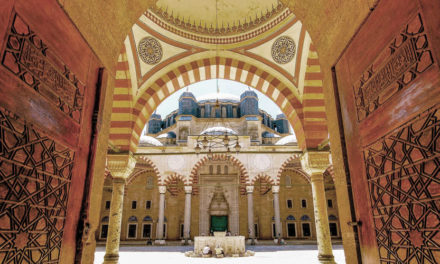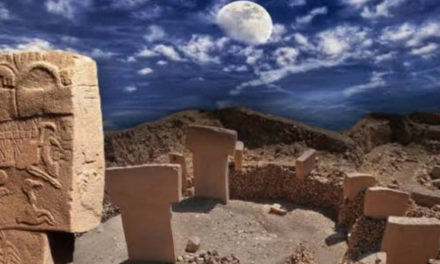Located in southwestern Turkey, in the upper valley of the Morsynus River, the site consists of two components: the archaeological site of Aphrodisias and the marble quarries northeast of the city. The temple of Aphrodite dates from the 3rd century BC and the city was built one century later. The wealth of Aphrodisias came from the marble quarries and the art produced by its sculptors. The city streets are arranged around several large civic structures, which include temples, a theatre, an agora and two bath complexes.
Aphrodisias is located in southwestern Turkey, in the fertile valley formed by the Morsynus River, in the ancient region of Caria. The serial property consists of two components. The first component encompasses the archaeological site of Aphrodisias following the city walls that encircle the city; and the second component includes the marble quarries located northeast of the city. Aphrodisias was founded as a city-state in the early 2nd century BC. An orthogonal street grid defines the pattern of the city; only a few structures, such as the temple of the goddess Aphrodite, are not aligned with the grid. Because the city shared a close interest in the goddess Aphrodite with Sulla, Julius Caesar and the emperor Augustus, Aphrodisias came to have a close relationship with Rome. It obtained a privileged ‘tax-free’ political status from the Roman senate, and developed a strong artistic, sculptural tradition during the Imperial Period. Many elaborately decorated structures were erected during the period of Roman rule, all made from the local marble.
The Cult of Aphrodite was the most important cult of Aphrodisias. The sanctuary at Aphrodisias had a distinctive cult statue of Aphrodite which defined the city’s identity. The Aphrodite of Aphrodisias combined aspects of a local Anatolian, archaic fertility goddess with those of the Hellenic Aphrodite, goddess of love and beauty. This identifying image has been found from Anatolia across the Mediterranean, from the city of Rome to the Levant. The importance of the Aphrodite of Aphrodisias continued well beyond official imperial acceptance of Christianity; the Temple did not become a church until c. AD 500.
The proximity of the marble quarries to the city was a major reason that Aphrodisias became an outstanding high-quality production centre for marble sculpture. Sculptors from the city were famous throughout the Roman Empire. They were well-known for virtuoso portrait sculpture and Hellenistic-style statues of gods and Dionysian figures. In late antiquity (4th-6th centuries AD), Aphrodisian sculptors were in great demand for marble portrait busts and statues of emperors, governors and philosophers in the major centres of the empire – for example, at Sardis, Stratonikeia, Laodikeia, Constantinople and Rome. In this period they were the best carvers of marble statues of their day. The techniques used, the quality of local artistic design, and the production of advanced portrait sculpture gave Aphrodisias a unique place in the Roman world.
Another key aspect of Aphrodisias was its cosmopolitan social structure (Greek, Roman, Carian, pagan, Jewish, Christian) that is abundantly articulated in the site’s 2,000 surviving inscriptions.
Criterion (ii): The exceptional production of sculpted marble at Aphrodisias blends local, Greek, and Roman traditions, themes and iconography. It is visible throughout the city in an impressive variety of forms, from large decorated architectural blocks to larger than life-size statues to small portable votive figures. The proximity of good quarries with both pure white and grey marbles was a strong catalyst for the swift development of the city as a noted centre for marble-carving and marble-carvers. The ability of Aphrodisian sculptors was sought after in metropolitan Rome where signatures of Aphrodisian sculptors appear on some of the finest surviving works – for example, from Hadrian’s Villa at Tivoli. These sculptors were major participants in the Empire’s art market between the 1st and 5th centuries AD.
Criterion (iii): Aphrodisias occupies a pre-eminent place in the study of sculpture in the Roman world. Its quarries and its sculpture workshops made it a major art centre, famous for the creativity and technical skill of its sculptors. Aphrodisias has one of the very few known and systematically excavated sculpture workshops of the Roman Empire, which provides a fuller understanding of the production of marble sculpture than anywhere else in the Roman world.
Criterion (iv): Aphrodisias is an exceptional example of the built environment of a Greco-Roman city in inland Asia Minor. Several of its monumental marble buildings have unique features in terms of architecture and design. The Sebasteion, an elaborate cult complex for the worship of Augustus and the Julio-Claudian emperors, represents a distinctive integration of Hellenistic, Roman and Aphrodisian artistic traditions. The “Archive Wall” in the theatre is a well-preserved collection of official imperial documents regarding the status of the city under the Empire. The Theatre also features an early example of a stage building with an aediculated façade. The Stadium has an unusual architectural form with two curved ends, known as “amphitheatral”, and is the best-preserved example of this type in the ancient world. The conversion of the Temple of Aphrodite into a cathedral, around AD 500, is unique among temple-to-church conversions in its engineering and transformative effect. The Tetrapylon, the conspicuous entrance to the outer Sanctuary of Aphrodite, is preserved with its elaborate and exquisitely carved architectural ornament.
Criterion (vi): Aphrodisias was famous in antiquity as the cult centre of a version of Aphrodite which amalgamates aspects of an archaic Anatolian fertility goddess with those of the Hellenic goddess of love and beauty. The Aphrodite of Aphrodisias appears in marble figures from the site of Aphrodisias as well as from many other locations around the Mediterranean. This dissemination of the cult image is strong evidence of the regional and supra-regional importance of the cult.
Integrity
The property includes all elements necessary to express its values and has not suffered from significant geomorphological change or intensive human occupation since antiquity. The limits of the property ensure full representation of the attributes conveying the Outstanding Universal Value of both the city and the marble quarries. The property has been legally taken under control by the State, and appropriate policies and actions have been proposed within the conservation and management plans in order to sustain the integrity of the site.
Authenticity
The authenticity of the serial property is established through its quarries, monuments and sculptures, about 2,000 surviving inscriptions, a comprehensively studied history and a substantial body of published research. The work of conservation and restoration at Aphrodisias has been undertaken in conformity with the Charter of Venice, respecting their original designs and building materials. The landscape surrounding Aphrodisias has not been exposed to modern development or to mass tourism.

